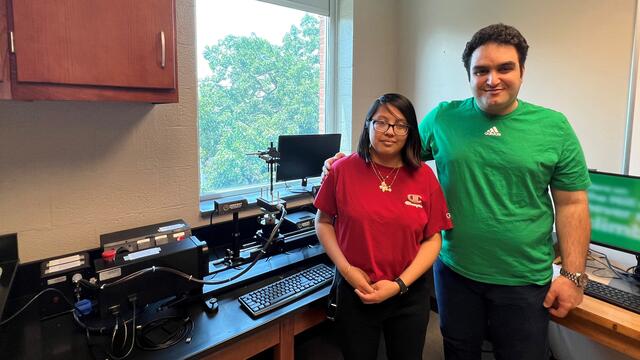Physics major makes a splash in thermodynamics summer research
Assistant Professor of Physics and Engineering Farzad Ahmadi and Tania Mendez-Perez, a senior Physics major specializing in Engineering, are studying how water droplets react to superheated surfaces, particularly those exhibiting porosity. Their project is a part of the Student-Faculty Collaborative Summer Research Program.

In addition to current summer research, senior Physics major Mendez-Perez is working to modify the contact angle goniometer / tensiometer instrument to prepare it for future experiments on the surface tension of liquids under different conditions.
If you’ve ever dripped water onto a very hot pan, you may have seen the droplet bounce and roll before it evaporates. It’s a common phenomenon called the Leidenfrost effect, and researchers at McDaniel are studying it to better understand why water reacts that way on super-heated surfaces.
Assistant Professor of Physics and Engineering Farzad Ahmadi and Tania Mendez-Perez, a senior Physics major specializing in Engineering, are continuing a project that Ahmadi began as a post-doctoral researcher at University of California, Santa Barbara. Their current work is part of McDaniel’s donor-supported Student-Faculty Collaborative Summer Research Program.
"I’m learning new skills in the fields of engineering and physics and applying them right away."
Ahmadi was first inspired to begin researching the Leidenfrost effect during a walk on a California beach, when he noticed the cold ocean water landing on heated sand. To further investigate the interaction between water and a hot, granular medium, he embarked on a series of lab tests.
He began by collecting high-speed videos of water and isopropyl alcohol droplets falling from various heights and landing on different heated materials.
Like you may have seen on a hot pan, a water droplet may immediately evaporate at a lower temperature, but with the Leidenfrost effect, when the surface is much higher than the boiling temperature of water, the droplet will “sit on its own cushion of vapor,” says Ahmadi, making it roll or bounce without evaporating. Why does that happen?
“Instead of immediately boiling away, the liquid forms a thin layer of vapor between itself and the hot surface. This vapor layer provides insulation, reducing the rate of heat transfer and allowing the liquid to ‘levitate’ or glide on the surface,” Ahmadi says.
Leidenfrost effect:
when a liquid meets a surface higher than it's boiling point, a cushion of vapor forms between liquid and surface, causing it to hover, bounce, and leap.
“In other words, we can say the heat isn’t communicated between the water and the surface because of the air-layer barrier," he adds. "In the context of water droplets on a superheated smooth surface, this phenomenon occurs when the surface temperature reaches approximately 150 degrees Celsius, or 302 degrees Fahrenheit.”
This results in a variety of bouncing, breaking, and flying droplets captured by Ahmadi in slo-mo, which Mendez-Perez is analyzing play-by-play to note distance, size, and other variable data.
“I’m getting a gist of how research actually happens in the real world, like properly gathering data,” Mendez-Perez says. By studying the phenomenon in action and learning to ask the right questions, she says her understanding of thermodynamics is better than ever.
Why study how water behaves on heated surfaces? In situations where high heat and water are present, like putting out a fire, knowing how water responds to specific materials and temperatures can help reduce risks of spreading potentially harmful particles through bouncing water droplets.
On the other hand, data from these experiments could help researchers harness the Leidenfrost effect to purposefully spread particles through water or use boiling as a method to lift particles.
“I’m learning new skills in the fields of engineering and physics and applying them right away,” Mendez-Perez says. Once the data analysis is complete, she will complete a final research paper. Ahmadi believes that communicating research, especially to a wide audience, is a crucial part of the process.
“If we aim to communicate science effectively, breaking it into easy and digestible pieces is essential,” Ahmadi says. “By simplifying and segmenting complex concepts, we can easily put the pieces together like a puzzle and present them, while appreciating the beauty of physics.”